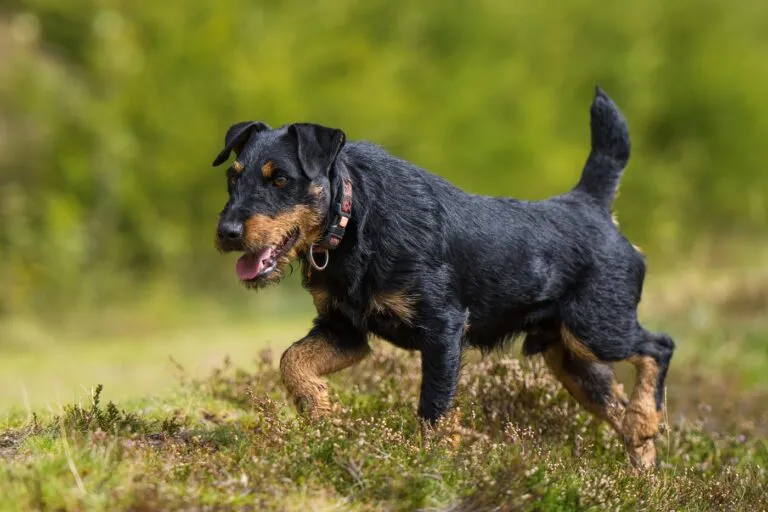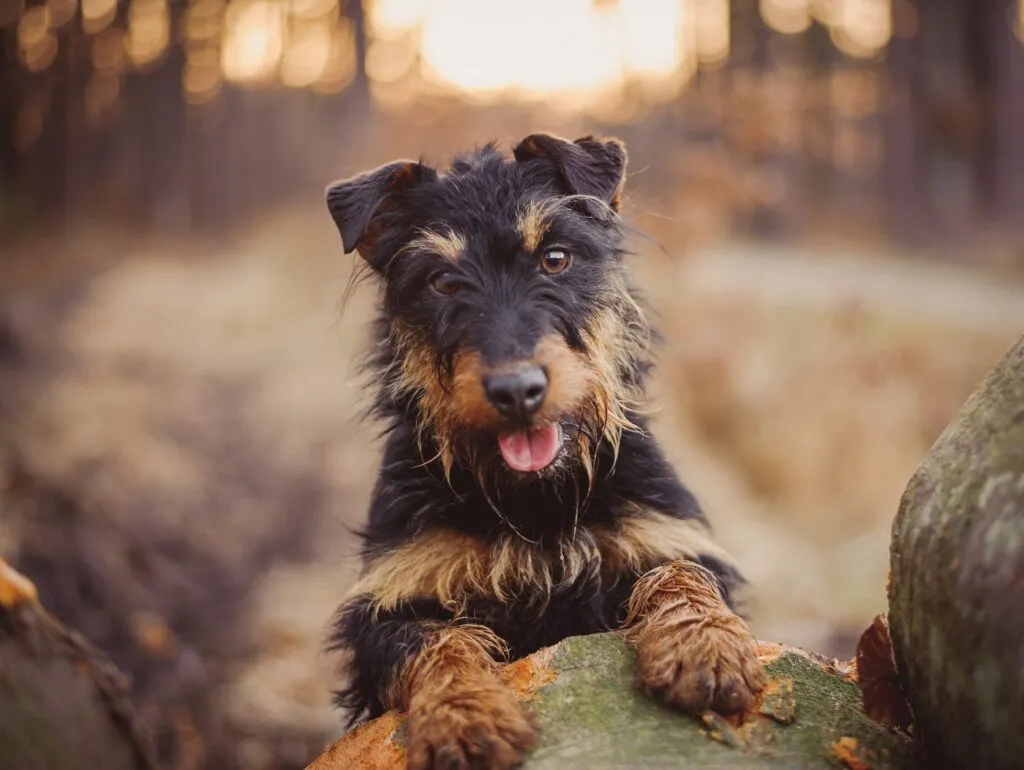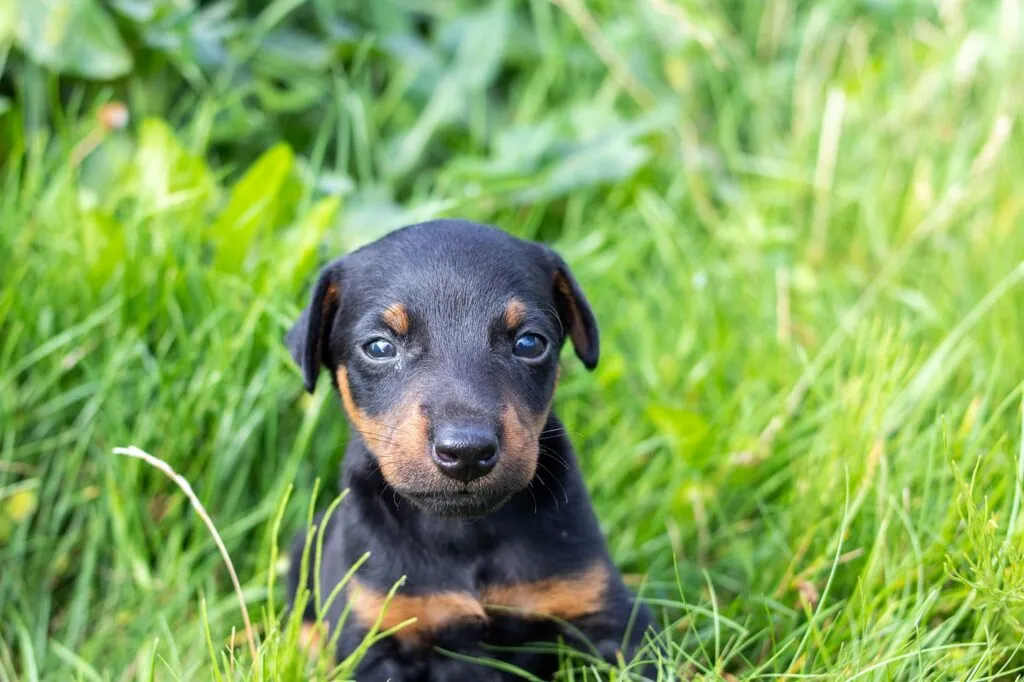Medium Size Poodle
Among hunters, a German Hunting Terrier is considered a versatile hunting assistant, often used for digging as well as flushing game. Thanks to its excellent nose, it reliably assists in hunting foxes, badgers, birds and wild boar. However, this spirited, strong-willed dog is not suitable as a pure family pet.

© DoraZett / stock.adobe.com
The German Hunting Terrier is a nimble, hardworking companion in the hunt.
German Hunting Terriers are small to medium-sized dogs, reaching a height at the withers of 33 to 40cm. Their build appears well-proportioned: the chest is narrow, the skull broad and flat. The weight for this long-legged breed is 9 to 10kg for males, and 7.5 to 8.5kg for females.
The coat of the German Hunting Terrier is short, dense and rather harsh. There are both rough-haired and smooth-haired varieties of this breed. The base colour of the coat is black, dark brown or black-grey mottled with clearly defined markings in red-yellow. Small white patches on the toes and chest, as well as a dark or light mask, are allowed according to the breed standard.
Its ears are set high and V-shaped, and its small eyes are somewhat recessed. The jaw of the German Hunting Terrier is long and equipped with a strong set of teeth.
The German Hunting Terrier is a brave, reliable hunting dog, bred specifically for hunting. While not aggressive, it can be wary of strangers.
Like all terrier breeds, it shows a certain stubbornness and therefore requires consistent yet loving training and leadership. It forms a strong bond with its caregiver, showing cooperation and a willingness to learn. Early socialisation in puppyhood is vital.
When well-trained, the German Hunting Terrier is a sociable companion and loyal hunting partner.
 © Snowboy / stock.adobe.com
© Snowboy / stock.adobe.com
As a hunting service dog, the German Hunting Terrier wants to fulfil its purpose and hunt. If it does not get enough mental and physical stimulation, behavioural problems may arise. If its need for activity and its hunting instinct are not met, it may seek challenges on its own.
It is naturally incompatible with cats and other pets such as rabbits and birds, potentially posing a danger to them.
Although the German Hunting Terrier often gets along well with children, it is not purely a family dog. It prefers chasing foxes, birds and wild boar over cuddling on the sofa or playing in the garden. Only if it is well-exercised and mentally stimulated does this curious, agile dog become a well-behaved household companion.
Originally bred for digging, its purpose has always been to fearlessly enter badger or fox dens and drive the animals towards the hunter’s gun.
Nowadays, this versatile hunting helper is also used in hunting cloven-hoofed game such as deer, stags and wild boar. It performs excellently both before and after the shot, is suitable for flushing out waterfowl and reliably retrieving game.
Those frequently out and with little time for the daily exercise needs of a German Hunting Terrier should consider another breed.
Alternatives to hunting include endurance jogging with the dog as well as various dog sports like agility and dummy training. If not kept for hunting purposes, the owner should have experience with hunting dogs to meet this dog’s needs.
The hardy coat of the German Hunting Terrier is not very high-maintenance. Weekly brushing is enough to remove loose hair. Bathing is usually unnecessary.
After hunts, the dog’s skin should be checked for injuries and ticks. Additionally, its ears, eyes and jaw should be regularly inspected to promptly identify and treat any health issues.
Active, energetic dogs like the German Hunting Terrier have higher energy needs than more sedentary counterparts. After strenuous hunts and exhausting mountain treks, this dog requires more food than others. High-quality, energy-rich dry or wet food is recommended.
However, be careful not to overfeed it to prevent obesity. Aside from activity levels, factors like age and weight are crucial in calculating the individual food requirement. Any allergies must also be considered.
This breed is relatively free of hereditary diseases. Only sometimes a genetically determined lens displacement, potentially combined with glaucoma leading to blindness, is observed. Tests are available to exclude primary lens luxation (PLL).
 © Ольга Ястребова / stock.adobe.com
© Ольга Ястребова / stock.adobe.com
With proper care, the German Hunting Terrier can live a long life, typically 12 to 14 years. Some individuals live even longer.
The German Hunting Terrier is a relatively young breed, starting after the First World War. Several hunters aimed to breed a small, black-red hunting dog focusing on performance rather than looks.
In their opinion, the Fox Terrier had become too much of a fashionable dog, losing its hunting properties. Their goal was to restore the original terrier, an unwavering hunting companion.
The breed’s foundation consisted of four black-red Fox Terriers acquired from the director of the Hamburg Zoo, Carl Hagenbeck.
They crossbred other breeds such as the Old English Rough-Coated Terrier and the Welsh Terrier to create a new but more authentic-looking hunting dog. The result is a water-loving, loud-scenting, and gunsteady hunting companion.
German Hunting Terrier Acquisition
Those interested in this rather rare breed should contact specialised breeders or associations. These dogs are mostly bred by hunters and often only sold to hunters and foresters.
Sometimes, animal welfare organisations or animal shelters also have adult dogs of this breed available.
The German Hunting Terrier breed is well described by the phrase “A dog for the den and the boar”. This is a diligent hunting service dog best suited to experienced owners, ideally hunters.
When allowed to fulfil its purpose extensively, the German Hunting Terrier is a reliable, obedient companion that brings its owner much delight.
| Quick info: | German Hunting Terriers are versatile, brave working dogs. They are used, for example, in digging and water hunting. |
| Height at withers: | 33–40cm |
| Weight: | 9–10kg (male), 7.5–8.5kg (female) |
| Average life expectancy: | 12–14 years |
| Nature: | spirited, hard-working, strong-willed, obedient, intelligent, sociable |
| Coat: | short and dense, in smooth and rough variants |
| Coat colour: | black, dark brown or black-grey with markings in red-yellow |
| Training effort: | high |
| Grooming effort: | low |
| Exercise requirement: | high |
| Origin: | Germany |
Fans of the Bearded Collie agree that those who aren't familiar with this dog breed simply have to get acquainted with it. And those who have experienced how a Bearded Collie bolts across meadows with its flowing fur, how it rolls around full of energy and joy and how it attentively and observantly takes into account its owners wishes become simply addicted to this original dog breed and its unique charm.
The Goldendoodle isn't a breed, but a pairing between Golden Retrievers and Medium or Standard Poodles. Marketed as a low-maintenance dog for allergy sufferers, this hybrid is enjoying increasing popularity amongst dog lovers, similar to the Labradoodle.